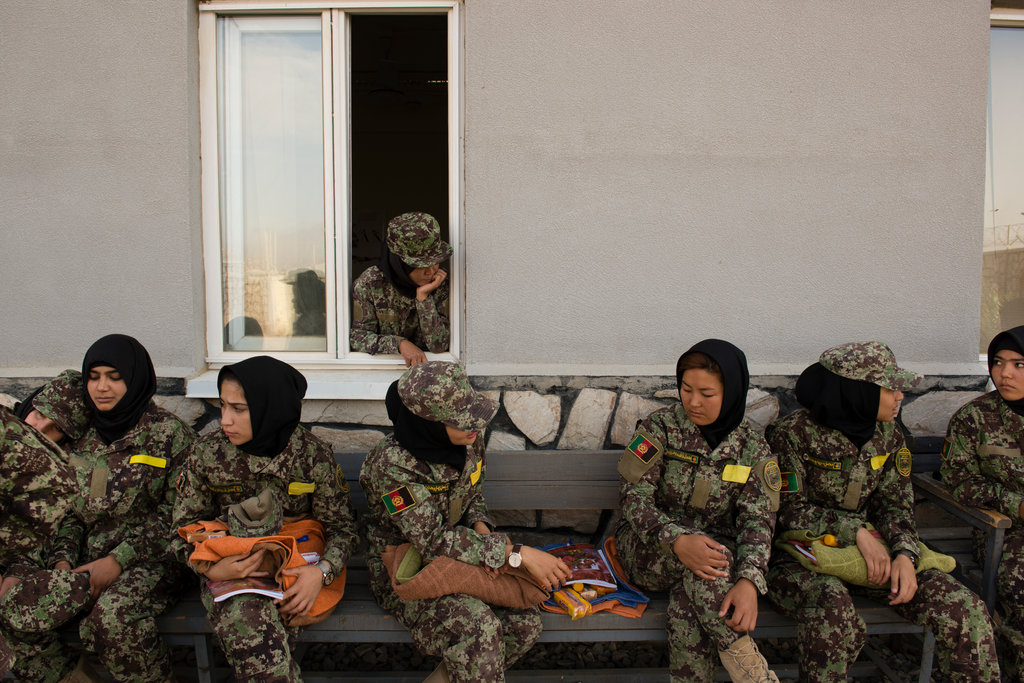Two dozen Afghan women in their early 20s, dressed in camouflage uniforms, trudge through prickly thistle plants under a nearly full moon. No one dares speak, the silence broken only by too-big army-issued boots crunching to a chorus of stray-dog howls and midsummer cricket chirps. It’s one of the first times these women, all seniors at the Afghan National Army Officer Academy in Kabul, have taken part in a nighttime exercise. Normally they would be tucked away in their dorm — its hallways plastered with posters of Marie Curie, Rosa Parks, Amelia Earhart and Col. Latifa Nabizada, Afghanistan’s first female helicopter pilot — surrounded by barbed wire.
Female cadets must adhere to a strict 9 p.m. curfew. But on this warm night, the women smile in the darkness, leaping over ravines and clambering up hills of dirt, spreading out into formation with their rifles in tow. Off in the distance is a flurry of commotion — the pop pop pop of blank rounds fired by their male counterparts; their flares pierce the night sky and set the dry grass ablaze. (The female cadets’ Afghan superiors have not yet allowed them to fire blank rounds or flares as part of a nighttime attack drill; so far, they’ve only had limited daytime firearms training.) Led by a female sergeant known to the women as Sergeant Hanifa, the group is flanked by American and British advisers who advocate drills like this while trying to navigate cultural norms that dictate how Afghan women must act and how they are viewed. In this case, in a bid to recruit more women, academy leadership has assured parents that female cadets won’t be out unsupervised at night, for their own protection.

Cadets picking up their weapons before a firearms lesson. Credit: Kiana Hayeri
“I have to do a head count, make sure we have all the lambs,” said Maj. Alli Shields of the British Army, using the nickname given to the women by Afghan male staff. “Or else this will be the first and last exercise.” Next to her stands Lt. Cmdr. Rebekah Gerber of the United States Navy, a senior gender adviser for the Afghan Ministry of Defense, who watches the drill with her hands on her hips, mentally taking notes. She’s one of a dozen advisers from NATO countries working with the Afghan government to integrate and support both men and women across the security sector. The lofty end goal: gender equality. A self-described fiery redhead pushing what she jokingly calls a “ginger gender agenda,” Gerber comes bearing a bold message for the Afghans and her coalition colleagues: “Get on board or get out — it’s happening.” It’s a job Gerber doesn’t take lightly. Deployed halfway across the globe from her four daughters — her second overseas deployment, after serving on a Navy ship in the Persian Gulf — she’s driven by thoughts of her girls back home “and for the women to come.”
Since NATO formally ended its 13-year combat mission in Afghanistan in 2014, drawing down a huge deployment of international forces, the United States and its allies have turned their attention to training, advising and assisting Afghan armed forces, trying to carve out a reality in which Afghanistan is able to defend and secure its own country without billions of dollars in foreign funding and assistance. Within that complex and intensely scrutinized mission is another, perhaps even more difficult, one: bolster the ranks of Afghan women in security forces, train them, promote them and keep them alive. Advisers like Gerber are tasked with leading that charge, part of a NATO policy born in the wake of United Nations Security Council Resolution 1325, passed in 2000, which stresses the importance of women’s involvement in global peace and security. Since then, a growing body of evidence has found that when women play a role in the security sector, take part in peace negotiations and are involved in rebuilding after war, women feel more comfortable reporting sexual violence and nations enjoy a more stable and lasting peace. To enact the resolution and appease international donors eager to support women’s rights, Afghanistan, a United Nations member state, adopted an internationally funded national action plan that details everything from engaging men in addressing violence against women to including women at decision-making levels nationally, regionally and locally.
But 17 years into America’s longest war, in which the argument for protecting and “saving” Afghan women has long shaped the rhetoric to invade and maintain troop presence, their advancement in the security sector is still largely at odds with cultural perceptions of women’s place in society. Progress, as defined by the United States and NATO leadership, has been painfully slow, and there’s concern that programs to recruit and train women have only put them in more danger. Despite billions of United States tax dollars spent on bolstering Afghan troops and paying their salaries — nearly $160 million budgeted in the last three years alone to support female forces — Afghanistan has never come close to its set recruitment benchmarks for women. Those involved in and familiar with NATO gender efforts say it could take generations before real, lasting progress is made for Afghan women in uniform.
Read full article here.


 Sophia Jones
Sophia Jones
